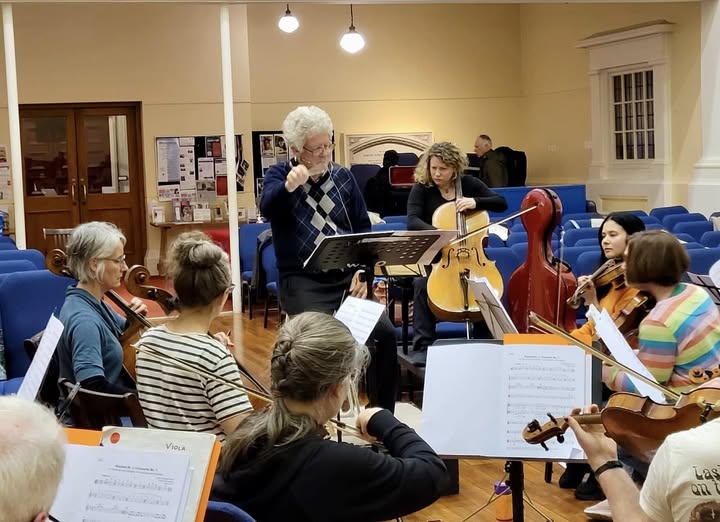 Donald Maurice (conductor) and Inbal Megiddo (‘cello) rehearse Shostakovich with the Wellington City Orchestra, December 2024, at St.Andrew’s Church, Wellington
Donald Maurice (conductor) and Inbal Megiddo (‘cello) rehearse Shostakovich with the Wellington City Orchestra, December 2024, at St.Andrew’s Church, Wellington
DOUGLAS LILBURN – Overture “Aotearoa” (1940)
DMIYTRI SHOSTAKOVICH – Concerto for ‘Cello and Orchestra No. 1 Op. 107 (1959)
ANTHONY RITCHIE – Symphony No. 5 “Boum” Op.59 (1993)
Inbal Megiddo (‘cello)
Wellington City Orchestra
Donald Maurice (conductor)
St.Andrew’s-on-The-Terrace Church, Wellington
Sunday, 7th December 2024
A review of the film of this concert courtesy Angus Webb (recording) and Nick Baldwin (camera),
written by Peter Mechen for “Middle C”
To my great disappointment I couldn’t, for various family reasons, get to this concert and had to perhaps settle for the once-removed pleasure of reading a review or possibly even getting to hear a recording. I was then contacted by the orchestra’s newsletter editor, Jeannine Thomas, who told me the concert actually hadn’t been reviewed, and asked me whether I might be able to at least contribute some comments on the performances from the DVD recording made of the occasion. I agreed somewhat reservedly at first – but to my surprise, the further I went into the DVD of the concert the more I became convinced it would be a splendid thing to do! Angus Webb’s recording seemed to me right from the outset to “catch” a nicely-balanced sound-quality; and Nick Baldwin’s camera-placement, though static, actually gave me a real sense of a well-placed seat in the organ gallery with a view of the whole orchestra. And as for the performances – well, what might I suggest but that one should read on and take the plunge with me into what proved to be an exhilarating and sumptuous feast of music-making! I must add an apology for the lateness of this review in relation to the actual event – but now that the time-toll of the initial delay plus the demands of the festive season has been duly paid, everything can happily proceed!
And what a programme! – beginning with perhaps the most iconic single piece of New Zealand composition penned for orchestra, Douglas Lilburn’s Aotearoa Overture, now eighty-plus years old, and still sounding as fresh and ambient as when it was completed in March 1940, in London, at the conclusion of Lilburn’s studies with the great English composer Ralph Vaughan Williams. In a matter of weeks after completion the work had its first performance as part of a concert organised to celebrate New Zealand’s centenary, with expatriate New Zealander Warwick Braithwaite conducting the Sadler’s Wells Orchestra. By August of that year Lilburn had returned to New Zealand, the young composer describing his elation upon catching sight from his trans-Tasman boat of Mt. Cook and Mt. Tasman with the words “My heart gave thanks with recognition that I’d returned”, sentiments whose heartfelt feelings he’d already in a sense “composed” as the music for his Aotearoa Overture.
Other Kiwis have since described similar kinds of feelings when hearing this music while overseas – there’s also a growing feeling that in hindsight the piece ought to have been used to preface the famous 1970 Expo film “This is New Zealand” rather than the Sibelius piece the film-makers chose at the time. Self-doubts of this kind are unlikely to recur, as the strength and purpose of Lilburn’s example has since empowered generations of younger composers who have readily “learned the trick of standing upright here” – and not only here but out there in a wider world of creativity.
The Overture begins with pure inspiration, two flutes springing rapturously into the air from an opening pizzicato chord with a long-breathed melody largely in thirds and augmented by gloriously arching strings and rolling timpani, building through these sounds for our mind’s eye aspects of a landscape we ourselves know and identify with so well. Conductor Donald Maurice and his players gradually widen and strengthen the vistas, while encouraging a growing excitement brought to the sound picture by the brass with fanfare-like shouts and calls to attention which leave us longing to be drawn further into the terrain’s mysteries and marvels. Strings and timpani beckon us into a rippling, rushing, almost volatile texture of sounds which winds brass and percussion evocatively join in with detail – quixotic birdsong, tides breaking over rugged coastlines, bush-clad hillsides and distant splendour of snow-capped peaks. All of this stimulates both tactile pleasure and in places a deeper wonderment, the music taking us between pictorial images and soliloquy-like expressions of awareness at the character of the surroundings and a sense of belonging.
Suddenly we are brought back to the strings-and-timpani opening (catching the timpanist out, here, momentarily) as Lilburn gathers the strands together and builds towards exuding that same “thanks with recognition” which his writing of the work surely must have anticipated. Here conductor and players triumphantly arch the sounds upwards and onto the pinnacle of arrival with those characteristic thrusting impulses! bring about for us at the end.
One thinks more readily of the music of Sibelius or Vaughan Williams as company for Lilburn, so the choice of Shostakovich was a bold and enterprising step for the concert to take, expressing a different kind of solitude and artistic challenge for a composer. Shostakovich’s First ‘Cello Concerto was completed in 1959 and dedicated to the great Russian ‘cellist Mstislav Rostropovich, a younger, but long-time friend who had long wanted the composer to write a work for him to play. I read a rather amusing anecdote about Rostropovich shyly asking the composer’s wife, Nina, if he might ask her husband about this, to which she replied, “If you want Dmitri Dmitrievich to write something for you, then never – NEVER ask him or talk to him about it!” Rostropovich’s restraint eventually paid off when, in 1959 he was asked by Shostakovich to come and hear a new concerto, and play through it – upon assuring the composer that he liked the piece, Rostropovich was disarmed to learn that the work was to be dedicated to him!
Here the soloist was Te Kōkī School of Music’s Associate Professor in ‘Cello, Inbal Megiddo, a player who’s already demonstrated to Wellington concertgoers her superb technique and riveting communicative skills as a musician. Shostakovich wastes no time with introductory niceties, giving the soloist centre-stage immediately with his characteristic four-note motiv that haunts this work, a figure the composer used elsewhere in various forms as a kind of signature (the notes G,F-flat,C-flat,B-flat correspond to D-S-C-H in German transliteration), such as in his Tenth Symphony and Eighth String Quartet. The motif is the dominant, even slightly paranoic presence of the movement which the composer styled as “an allegretto in the style of a comic march”, and one that also features the solo horn, the only brass instrument in the smallish orchestra.
Inbal Megiddo’s playing astonishes as the solo part becomes increasingly elaborate and jagged as the music grinds on. The orchestral winds are superb in their support for the soloist with a repeated rat-tat-tat figure, and various other sardonic gesturings adding to the music’s feeling of caricature – and the horn playing from Caryl Stannard is fearless and remarkable, having to repeat the cellist’s “signature” theme on a number of occasions and truly capturing its “obsessive” character. Donald Maurice keeps the band on its toes throughout the movement’s tricky syncopated passages, both throughout the opening, and when accompanying the soloist’s second subject and draws the utmost emotion from the horn with its account of the second theme’s anguished and obsessively mournful line.
A beautiful, husky cantabile from the strings introduced the second movement, with suitably mournful tones from the horn bringing in the soloist, the latter ably accompanied by the violas – and how lovely and withdrawn is that “stricken” playing from the strings a little later, taken up by the ‘cello, and all in very heart-rending fashion! –a slightly jauntier air brings a glimmer of light but all too soon turns to angst and anguish, the orchestra pitching in with heartfelt solidarity. Suddenly the horn sounds a kind of warning, by way of announcing what’s probably the work’s most remarkable passage, with the soloist playing in eerie harmonics accompanied by the celesta and “lost and wandering” figurations from the other strings, and a soulful clarinet – the music sinks helplessly to the ground,as Megiddo begins the elaborate cadenza that make up the work’s third movement.
This was a spell-like montage of soliloquy, pizzicato both agitato and mysterioso, single-instrument dialogues building up up to agitated passagework whose compelling exertions suggest the motif that began the symphony, priming us for the orchestra’s sudden reawakening. And so conductor and players begin to build, push around and stack up blocks of the finale’s music, leading to the moment when the motif which began the work takes hold of it again and gives everything and everybody – soloist, orchestra and audience – a massive shake-up and drops us onto the floor! – (yes, I say “us!”, because by this time I’ve broken through the membranous tissue separating performance and film viewer, and am in there with the players and audience!) – and despite our exhaustion we can’t help the feeling of exhilaration! We get up, look around, and it’s over! – we’ve made it home! – what a ride! – Kudos to all!
One presumes an interval followed all of this, enabling everybody, myself included, to “find” their place in the scheme of things once again and get their batteries of all kinds recharged for the concert’s second half, the presentation of a work whose composer, I believe was present for the occasion. A pre-concert Facebook post from Anthony Ritchie articulated some of the excitement and expectation associated with the event (I quote his own words): “I’m really pleased the Wellington City Orchestra is playing the work and I am coming up for the occasion – I haven’t heard it live for a while! I have known members of the orchestra, including my cousin Anne Ballinger on the flute, and have collaborated with Donald Maurice on many projects in the past. I’m glad he is at the helm.”
Of course there’s always something special about a performance attended by the composer, as I’d registered just a short time ago at Orchestra Wellington’s “A Modern Hero” concert at the start of which Auckland composer Eve de Castro Robinson’s work Hour of Lead was given its premiere with the composer herself present – a real buzz! One takes on for one’s own delectation some of any composer’s imagined feelings upon hearing both inspiration and perspiration come to fruition, whether for the first or fiftieth time! How lucky we are to have such people so readily accessible, and so tangibly, to boot!
Ritchie’s First Symphony dates from 1993, while he was Composer-in-Residence with the Dunedin Sinfonia, and received its first performance within a year with Sir William Southgate conducting the same orchestra. The work’s title, “Boum”, is inspired by an incident in E.M.Forster’s novel “A Passage to India” where two of the characters enter the Marabar Caves and experience a mysterious echoing sound which takes on a symbolic meaning in the story relating to the same characters’ grasp of their differing realities. Ritchie uses a tam-tam to replicate this echo throughout the symphony as a kind of “motif”, sonorous and purposeful at the beginning and varying in intensity as the music indicates.
It’s all quite an adventure on its own! – what stays in the memory after the tam-tam opening, is the gathering of momentums whose energies build to elemental proportions, a saxophone delighting us with a sinuous, suggestive alternative character, and an oboe line getting a deliciously eerie, sinuous backdrop from the strings. The winds here have a fine time playing their themes in canon until a solo cello calls “Enough!” on the fun with a figure that contains the inklings of a march, at first teasingly “played with” by the saxophone and winds, but excitingly burgeoning until the tam-tam reasserts its presence! The march ceases and the music floats upwards through a winsome series of airborne phrasings, brought again to earth by a softer but just as implacable tam-tam stroke at the movement’s end! So! – what next?
The second movement’s a frenetic dance driven by Cook Island log drums in regular attendance! – Conductor and orchestra relish the enjoyment, as winds and a horn reiterate a three-note fanfare which a perky theme attaches itself to in a cheeky array of guises, The log drum introduces a string quartet and then a wind ensemble, and, of course the brass can’t be kept out of the fun at this point, the players having a ball with their outlandish whooping and blaring! The saxophone also can’t be kept quiet, beckoning its fellow-winds to speak out as the brasses and percussive forces keep the rhythms going, with great, on-the-button work from all concerned! Out of this comes a plaintive theme from the strings echoed by brass and then indulged in by the whole orchestra!. But, of course, the music’s “got rhythm!” – and back comes the opening to hammer the movement to its conclusion!
By contrast, winds begin the slow movement as a lament, karanga-like in its expression of grief as a solo cello further internalises the same. The upper strings beautifully float an elegiac line, joined by the saxophone – the ambience turns back to tragedy as winds, brasses and solo sax are joined by tolling bells underlining the sombre mood, the composer intending this music as a tribute to the victims of the Bosnian wars of that time. Strings seek to comfort but are overtaken by a remorseless build-up of harrowing tones, superbly controlled, the climax echoed by melismatic wind arabesques, the brass entering to underpin the note of tragedy. Beautiful solo string-playing leads to several concluding doom-laden double-bass rumblings, and silence – a bereft, grief-ridden world of its own but one of course tragically echoing present day conflicts and lamenting still more innocent victims.
I loved the darkly rumbustious beginning of the finale, in places reminiscent of Holst’s Ballet Music “The Perfect Fool”, with its touches of sorcery and mischief, a mood which then abruptly changes with what seems like graceful dance-steps by the strings , but gradually becomes almost rock-music rhythmed, the playing generating plenty of exuberance, and a sense of striving towards joy! – the kind of thing that a modern-day Bach might put into a Brandenburg Concerto! Ritchie then, by a further piece of delicious alchemy, brings in his winds to perform a Caribbean-like dance which spreads through the orchestra, pizzicato strings and cruising brasses also “hep to the jive”, the different orchestral sections alert and alive! The return of the tam-tam strokes seems if anything to goad the rhythms into even greater exuberance, until a hugely reproving and resonating blow curbs any further escalations, and casts an “envoi-like” feeling over the rhythms – their gradual diminution leads to a farewell statement by the string quartet of the symphony’s beginning and a final tam-tam stroke – a wonderful moment and beautifully-wrought ending!
What joy, what relief and what pride and satisfaction would have accompanied this concert’s epic achievement on the part of all the musicians! And how wonderful that technology keeps it all alive, so that it’s more that either just a memory or a reminiscence such as that which I’ve been privileged to give, here. Something definitely to remember an already momentous and historic year by, and return to with lasting pleasure!
 Wellington City Orchestra presents:
Wellington City Orchestra presents:
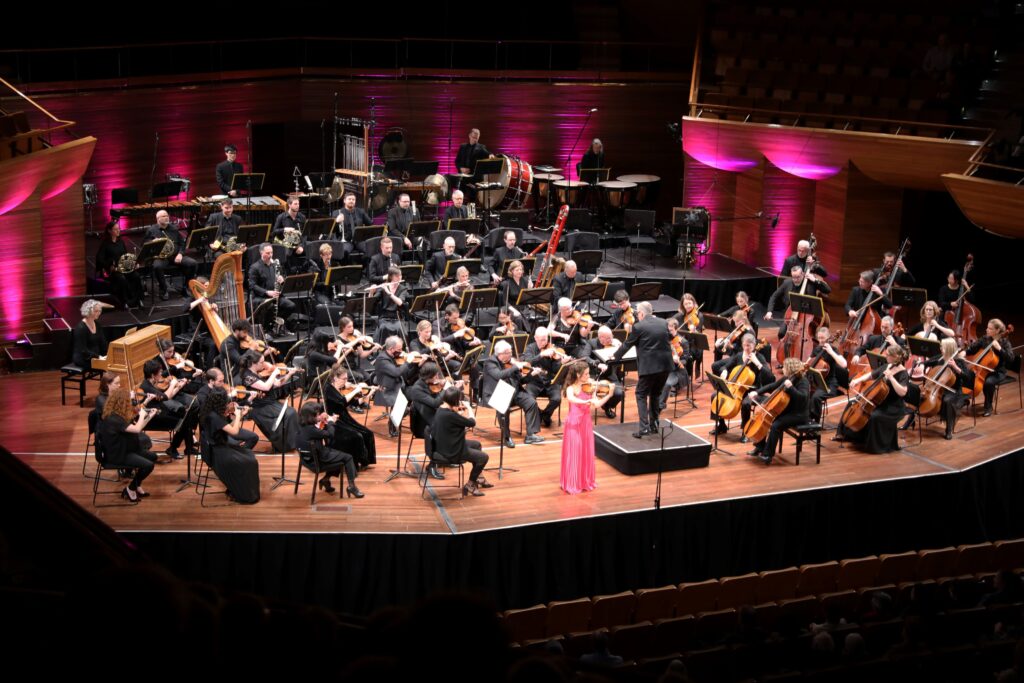
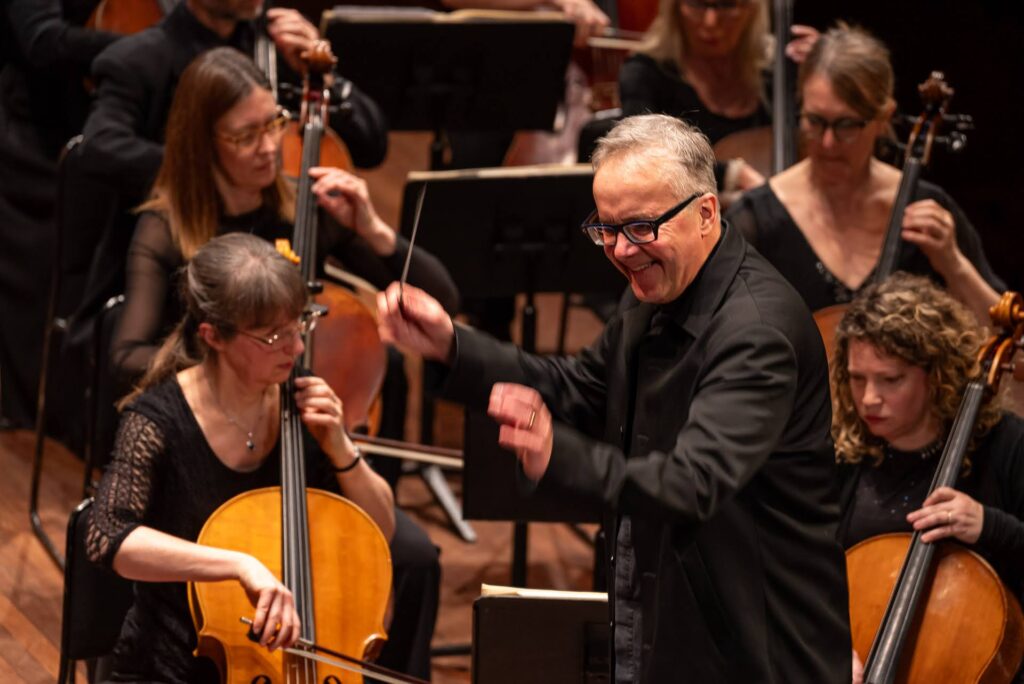 Orchestra Wellington Music Director, Marc Taddei – photo credit: Latitude Creative
Orchestra Wellington Music Director, Marc Taddei – photo credit: Latitude Creative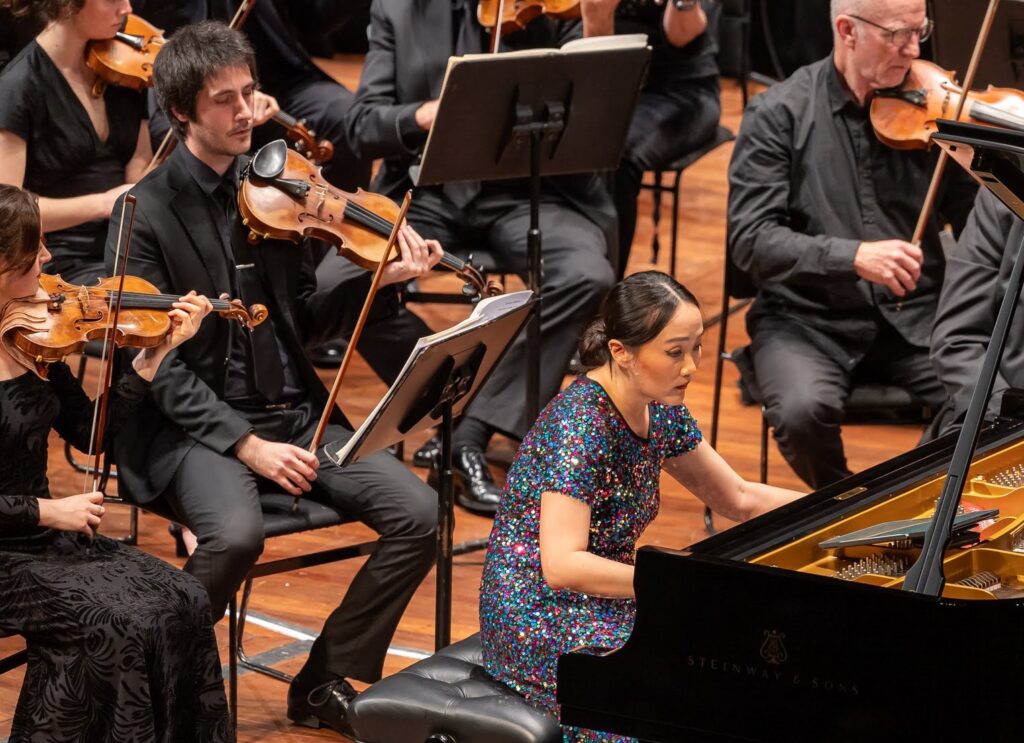 Somi Kim, piano, plays Germaine Tailleferre’s 1924 Piano Concerto with Orchestra Wellington – photo credit: Latitude Creative
Somi Kim, piano, plays Germaine Tailleferre’s 1924 Piano Concerto with Orchestra Wellington – photo credit: Latitude Creative Soloists Emma Pearson (soprano), Margaret Medlyn, (mezzo-soprano), Emmanuel Fonoti-Fuimaono (tenor) and Robert Tucker (baritone), with the Orpheus Choir of Wellington, Orchestra Wellington, and Music Director Marc Taddei – Photo credit: Latitude Creative
Soloists Emma Pearson (soprano), Margaret Medlyn, (mezzo-soprano), Emmanuel Fonoti-Fuimaono (tenor) and Robert Tucker (baritone), with the Orpheus Choir of Wellington, Orchestra Wellington, and Music Director Marc Taddei – Photo credit: Latitude Creative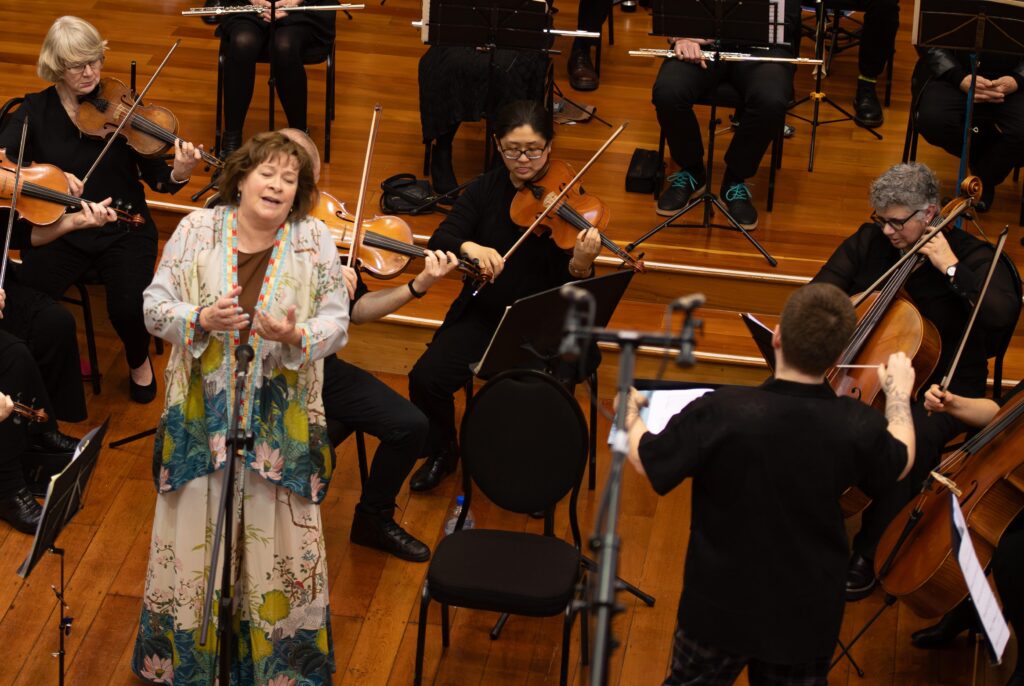 Anna Gawn performs Ross Harris’s Klezmer Suite with Rachel Hyde conducting the Wellington City Orchestra
Anna Gawn performs Ross Harris’s Klezmer Suite with Rachel Hyde conducting the Wellington City Orchestra